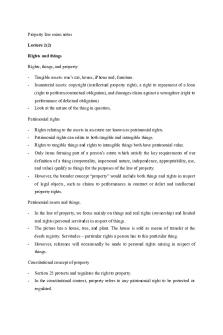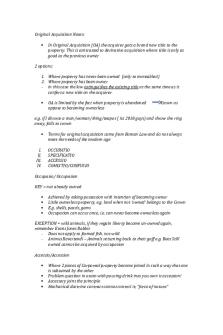Accession notes - Summary THE LAW OF PROPERTY PDF

| Title | Accession notes - Summary THE LAW OF PROPERTY |
|---|---|
| Course | The law of Property |
| Institution | University of Aberdeen |
| Pages | 4 |
| File Size | 86 KB |
| File Type | |
| Total Downloads | 23 |
| Total Views | 172 |
Summary
More structured notes on accession ...
Description
Original Acquisition Notes:
In Original Acquisition (OA) the acquirer gets a brand new title to the property. This is contrasted to derivative acquisition where title is only as good as the previous owner
2 options: 1. Where property has never been owned (only to moveables!) 2. Where property has been owner - in this case the law extinguishes the existing title at the same time as it confers a new title on the acquirer
OA is limited by the fact when property is abandoned oppose to becoming ownerless
Crown as
e.g. if I divorce a man/woman/thing/teapot ( its 2018 guys) and throw the ring away, falls to crown
I. II. III. IV.
Terms for original acquisition come from Roman Law and do not always meet the needs of the modern age OCCUPATIO SPECIFICATIO ACCESSIO COMIXTIO/CONFUSIO
Occupatio/ Occupation KEY = not already owned
Achieved by taking possession with intention of becoming owner Little ownerless property, e.g. land when not ‘owned’ belongs to the Crown E.g. shells, pearls, gems Occupation can occur once, i.e. can never become ownerless again
EXCEPTION = wild animals, if they regain liberty become un-owned again, remember Evans Jones Rabbit - Does not apply to farmed fish, not wild - Animus Revertendi – Animals returning back to their gaff e.g. Bees Still owned cannot be acquired by occupation Accessio/Accession
Where 2 pieces of Corporeal property become joined in such a way that one is subsumed by the other Problem question in exam with pouring drink into you own is accession! Accessory joins the principle Mechanical doctrine contract cannot control it; “force of nature”
- [Shetlands Islands Council v BP] e.g. house accedes to land- window frame accedes to house and thus land also 3 Elements needed I. II. III. -
Physical Union [Christie v Smith’s Exuctrix] > 2 tonne summer house > greater the attachment the more likely accession has operated Functional Subordination i.e. must have a functional use to the other [Cochrane v Stevenson] > paintings and decorations have no functional subordination The Summer house in the Exutrix case filled a gap in the wall so helped enjoy the farm better Permanency [Brands Trs v Brands Trs] > only quasi-permanency needed [Howies Trs v McClay] > lace looms fitted to house > house altered so accession occurred Erskinne: A moveable thing may become immovable when FIXED or UNITED to another thing for its PERPETUAL use
Accession has 3 effects: 1. 2. 3. -
Accessory becomes part of Principle Principles rights encapsulate accessory ‘Conversion’ i.e. moveable > heritable Occurs when moveable accedes to heritable E.g. bricks (moveable) accede to house and become heritable by definition Existing title to accessory extinguished Gives party ownership If Jeff’s bricks used to lay Bill’s house without consent of J, he has a compensatory claim B is owner
If accessory is ‘severed’ from the original, then 1 and 2 are reversed, but 3 not affected. E.g. if J huffs and puffs and blows house down he gets bricks back but they still belong to B.
Accession of Moveables to Land
This is called a ‘fixture’, they are NOT ‘fittings’ i.e. furniture in the house > this has not acceded 3 conditions for accession: If physical union element provides decisive result other 2 don’t need to be considered E.g. heavy object may accede because of weight alone
“Functional subordination”;
Does the item appear to be attached for the improvement of the land or for the better enjoyment of the principle? KEY QUESTION E.g. heating system clearly improves house thus accedes > [Fife v Hodgson] Much depends on the circumstances. A picture is better viewed if hung but it also enhances the wall > [Cochrane v Stevenson] > look back they do NOT Accede in this case!
“Permanency”
-
Only Quasi-Permanency needed > [Brands Trs v Brands Trs] In the above case machinery installed by tenant on mining lease with intention of removing upon expiration Nonetheless it has acceded
Various factors need to be taken into account for permanency: a) If the physical attachment is greater than necessary to secure the item then that points to accession b) Mutual special adaption > e.g. lace looms case where building adapted to fit them c) Whether the item is something normally left or removed when a building changes hands. E.g. industrial machinery usually left d) Length of time it takes to install/uninstall. If it takes a long time then accession occurs
The intention if the person who installed the item is also relevant. However many say it is a ‘better view’ to take a more objective approach; “a fixture is a patent for the whole world to see”
Moveables to Moveables E.g. button to a shirt/paint to a car Same rules apply as for moveable to heritable [J L Cohen Motors v Alberts 1985] > wheels do not accede to car because they are easy to remove In establishing which is the principle: Bell > Where one cannot exist w/o other then it is the accessory > Where they can exist separately the principle is the one ‘which the other is taken to adorn or complete’ > Bulk prevails; essentially bigger item can be interpreted as principle [Khan v Minister of Law and Order] Land to Land I. II.
E.g. land picked up by water and moved This is called an alluvio or alluvion Will accede to that which exists already Addition must be permanent Sudden changes do not count
E.g an avulsion caused by a storm An alluvion usually occurs from nature however it can be manmade [Stirling v Barlett] - Building of a wall caused debris to come floating down river “Fruits”
Where accessory is produced by the principle > accession by fruits E.g. crops/ fruit trees Young of animals accede to their mother, fruits to a tree, milk to a cow Separation does not change owner, a lamb would still belong to the mother...
Similar Free PDFs

Law of Property Notes
- 29 Pages

EXAM Notes - Summary Property Law
- 15 Pages

Law of property A notes
- 14 Pages

Intellectual Property Law – Notes
- 38 Pages

Property law exam notes
- 33 Pages

Property Law - lecture notes
- 112 Pages

Property Law A notes
- 7 Pages

Property LAW notes
- 45 Pages

Property Law Lecture Notes
- 30 Pages

LAW OF THE SEA Summary Notes
- 21 Pages
Popular Institutions
- Tinajero National High School - Annex
- Politeknik Caltex Riau
- Yokohama City University
- SGT University
- University of Al-Qadisiyah
- Divine Word College of Vigan
- Techniek College Rotterdam
- Universidade de Santiago
- Universiti Teknologi MARA Cawangan Johor Kampus Pasir Gudang
- Poltekkes Kemenkes Yogyakarta
- Baguio City National High School
- Colegio san marcos
- preparatoria uno
- Centro de Bachillerato Tecnológico Industrial y de Servicios No. 107
- Dalian Maritime University
- Quang Trung Secondary School
- Colegio Tecnológico en Informática
- Corporación Regional de Educación Superior
- Grupo CEDVA
- Dar Al Uloom University
- Centro de Estudios Preuniversitarios de la Universidad Nacional de Ingeniería
- 上智大学
- Aakash International School, Nuna Majara
- San Felipe Neri Catholic School
- Kang Chiao International School - New Taipei City
- Misamis Occidental National High School
- Institución Educativa Escuela Normal Juan Ladrilleros
- Kolehiyo ng Pantukan
- Batanes State College
- Instituto Continental
- Sekolah Menengah Kejuruan Kesehatan Kaltara (Tarakan)
- Colegio de La Inmaculada Concepcion - Cebu





